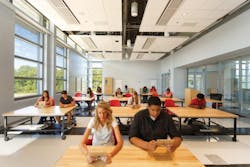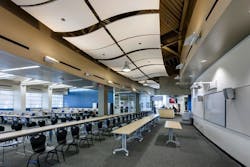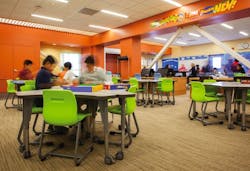BD+C special report: What it takes to build 21st-century schools
Florida’s Orange County Public Schools is the nation’s 10th-largest school district, with 180-plus schools and 192,000 students in grades K–12. Making changes in a district this size “is like trying to turn a battleship,” says Faz Ali, Senior Director of Planning and Design.
His district has been taking what he describes as “baby steps” toward embracing design and construction innovations aimed at making schools more student centered, project oriented, and technology enhanced. Those are the three signposts of what, for an increasing number of public school districts and private schools across the country, has come to define a so-called “21st-Century School.”
The pace at which K-12 schools are evolving has varied widely by district and state, depending on local demographics, funding, and preferred methods of pedagogy. Not every district is yearning for Montessori-style environments where the teacher is more “a guide on the side than a sage on the stage,” quips Dan Boggio, AIA, LEED AP BD+C, President/Founder of architecture firm PBK.
But innovations that AEC firms and educators have been advocating for decades are suddenly finding more receptive ears among school board members, school administrators, and voters, whose support for construction financing through bond issues and tax levies is essential to getting any project off the ground.
“There’s a host of different voices, requirements, and regulations” that go into building new schools, says Krisztina Tokes, Director of Facilities Asset Development for the Los Angeles Unified School District. She should know: in the last 15 years, LAUSD, the nation’s largest school district, has constructed 130 schools.
So the sooner an AEC firm can get involved in the planning discussions, she and other district officials say, the better its chances of winning over the numerous constituencies competing to achieve their educational goals within their capital expenditure boundaries.
WHAT IS A ‘21ST-CENTURY’ SCHOOL, ANYWAY?
One thing is clear: Despite myriad educational reforms that have come and gone since the 1960s, there is a growing anxiety within academic, government, and business circles that the traditional ways of teaching school children in institutional settings still need adjusting if the United States is to remain competitive internationally. To that end, more districts are making the connection between education and their physical learning environments.
In fast-growing Frisco, Texas, just north of Dallas, Cecil Cypert, Director of Construction Services for Frisco’s Independent School District, recites a wish list from his district’s curriculum director:
• Buildings that expose as many classrooms as possible to natural light
• A variety of spaces to support different learning styles and groups
• Movable and portable furniture (often the central component in modernizing existing schools)
• Social interaction spaces
• Technology that transforms learning spaces into businesslike settings
Orange County Public Schools is taking its cue from a recent study it completed to guide the district’s direction. “It told us that the old ways of teaching need to be updated,” says Ali. “What’s motivating change in our schools is globalization—that competition is everywhere, technology is changing everything, and the varying competencies of students, who don’t learn at the same pace.”
In 2011, the Department of Defense Education Activity (DoDEA), which oversees 78,000 students in 12 countries and seven U.S. states, launched its “Facilities for 21st Century Learning” program, with a target of renovating or building 130 schools. Mike Smiley, DoDEA’s Chief of Facilities, says the agency has been moving toward student-centered schools with collaborative spaces for what he calls “multidisciplinary” and “blended” learning.
Two of the 18 schools it has completed under this program so far—at Fort Bragg, N.C., and Quantico, Va.—were built from a 21st-century design template that features different-sized classrooms: 100 sf for one-to-one teaching, 200 sf for student groups working as teams, and 800 to 900 sf for “learning studios” with flexible or movable partitions, walls, and furniture.
The 129,577-sf elementary school at Quantico, which is scheduled to open next month, will accommodate 750 pre-K–5 students. The school, aptly known as “Crossroads,” originally was going to be a conventional school, but DoDEA decided to try out its new design guidelines instead. These guidelines are likely to show up in several of the 24 schools DoDEA has under construction and 29 others in design phases under this program, which should wrap up in 2019.
More school districts are conceding that historical K-12 learning practices—the classic classroom with a teacher lecturing—aren’t always effective, and are leaving too many students unprepared for college or the increasingly competitive workplace. “Districts understand that not everything can occur in a 900-sf classroom,” says Chuck Tyler, AIA, LEED AP, Senior Architect with design firm Fanning Howey.
In 21st-Century Schools, “learning takes place anywhere and anytime,” says Irene Nigaglioni, AIA, CEFP, LEED AP BD+C, Partner and National Planning Director at PBK. Hallways are opening up via glass or movable walls. That means there’s less demarcation between classrooms and corridors, which can double as collaborative work areas.
Her firm recently finished two ninth-grade schools in Houston, with 1,000 students each, that don’t have traditional cafeterias or libraries; instead, there’s one central circulation spine. Smaller learning centers jut off this 80x600-foot corridor, and tables, chairs, couches, bookshelves, and lounge areas are scattered throughout.
“It’s more like a Starbucks, and it’s completely wired,” says PBK’s Boggio. “The kids are interacting as they would in the real world.”
Ah, yes. The Real World. It sometimes seems like the whole point of 21st-century learning is to prepare students for a smooth transition into the job market. School districts are favoring designs that create the kind of collaborative, plugged-in workspaces one finds in offices. (The reverse is also possible: The Washington Post recently reported how some towns in Northern Virginia are converting excess office space into classrooms for elementary students.)
“Today’s students and parents are looking for relevancy from their schools,” says Greg Donovan, Superintendent for the Western Maricopa County Education Center (West-Mec) in Arizona, which oversees 24,000 students attending 46 career and technical high schools in 12 districts. “That’s why you’re seeing an upswing in charter schools, specialty schools, even schools within schools.”
BIG IDEAS ON CAMPUS
It’s worth stepping back here to point out that not every school that’s under construction or being planned will be a revolutionary departure from the status quo. There are still plenty of school districts and communities that are perfectly happy with traditional school setups.
What’s getting built these days invariably reflects the priorities of school districts and communities that don’t always revolve around au courant designs or engineering wizardry. New Mexico’s Public School Facility Authority—which since 2001 has managed over $3 billion in school improvements—focuses on reducing its schools’ footprints to lower their operating costs, says Robert Gorrell, the Authority’s Founding Director. He adds that the state expects its Building Teams to uphold “design and construction that’s sustainable, and not just energy saving.”
New Jersey’s Schools Development Authority oversees 31 of the state’s 656 school districts, provides grants for construction and renovation, and has a dozen schools under construction statewide. What keeps Charles McKenna, the SDA’s CEO, up at night is worrying about “predictability of cost and time of construction.” Some of these new schools will include L-shaped classrooms that allow for simultaneous student activities to occur in each section of the L. McKenna says more school districts are adopting what he calls “Teach-to-One” centers, where students rotate between large and small groups for project collaboration.
Other districts around the country are designing and building schools within schools that showcase their specialized curricula. “Rather than creating schools from scratch, says LAUSD’s Tokes, the mega-district has been developing different programs—for visual arts, STEM, vocational training, and so on—within its campuses.
The 11th high school in Houston’s Cypress-Fairbanks Independent School District, the third-largest in Texas, will be part of a 179-acre, 592,000-sf “educational village” that will eventually include a middle school and an elementary school.
This complex, whose first phase is scheduled to open in August 2016, will have a separate building with a kitchen, dining area, and culinary arts lab. Roy Sprague, AIA, CSI, CEPF, the district’s
Associate Superintendent, explains that this setup should reduce the number of food service staff needed to support the schools. Student instruction in culinary practices will also be offered there.
Sprague says he envisions a future partnership with a healthcare provider to build an on-campus facility for the surrounding community, one that could present work-study and educational opportunities for students. “Our goal,” says Sprague, “is to get our students career-ready.”
In the Houston Independent School District, Booker T. Washington High School is a designated High School for Engineering. Its specialized courses include rocket science, not surprising for an institution that aligns with NASA and other aerospace companies.
Louisiana’s East Baton Rouge Parish School District, with 42,000 students, is currently building a high school, scheduled to open in 2016, for more than 1,200 students. The school’s three buildings will offer specialized courses in health services, technology and electronics, and digital arts and media. District Superintendent Bernard Taylor says these buildings are being constructed to allow their classrooms to be repurposed, at a relatively minimal cost, as curriculum needs change.
Farther out on the design frontier is Rhode Island’s Department of Elementary and Secondary Education. Its 105,000-sf, two-story Claiborne Pell Elementary School, in Newport, divides into a PK–1st grade lower school and 2nd–4th-grade upper school. Each wing has dedicated specialty and support spaces, including art and music; and a shared activity center in the kindergarten corridor that teachers use for stories, performances, and hosting special visitors and events.
“Schools want students to be creative, communicative, collaborative, and critical thinkers,” says Laura Wernick, FAIA, REFP, LEED AP, Senior Principal with HMFH, the architecture firm for the Rhode Island school. Joseph DaSilva, the department’s School Construction Coordinator, says that planning Pell required an understanding of Newport’s “stratified” demographics as well as its architectural history. The school, located on the city’s North End, has helped to rejuvenate what had been a blighted neighborhood.
OVERCOMING PRECONCEIVED NOTIONS OF SCHOOL DESIGN
Generally speaking, AEC professionals say that the school districts they work with are eager to hear new ideas. For example, architectural giant Corgan might design a school prototype that gets used a dozen times, but also gets tweaked with each succeeding project. “The starting point is what we did in the last school: what worked, what can be improved,” says Brett Sumrow, an Associate Principal in Corgan’s Dallas office.
But many districts and states come to the table armed with guidelines that specify how they want their schools to get built.
About 600,000 of the 1.7-million-plus K-12 students in Ohio’s 612 districts attend schools that have been constructed or renovated since 1999. In 2011, the Ohio School Facilities Commission developed a design manual that guides new construction. The commission recently added a chapter on student-focused learning environments. It conducts pilot programs with different school districts to test ideas, and retains four educational planning firms as consultants available to all districts, says Melanie Drerup, Deputy Chief of Planning.
For the past four years, the New Jersey Schools Development Authority has made what McKenna, its CEO, calls a “big push” toward standardizing building materials and systems. This effort, he explains, includes devising a kit of parts that designates classroom models and sizes, color palettes, furniture, and other components—standards, McKenna insists, that still allow for local flexibility.
Several experts consulted for this article, including Jim DeLage, Project Executive with Turner Construction in Cincinnati, say that LEED and green building still play a major role in decisions about school design and systems.
Insulated concrete forms and geothermal systems are now standards for school construction in the Frisco ISD, says Cypert. Daylight harvesting, which is becoming routine in schools for its benefits to learning, comes with some tradeoffs. “When you let more natural light in, you sacrifice some of the ways to cost-effectively build a school,” notes Clint Fawcett, Chief Estimator, McCarthy Building Companies. Adding larger windows usually requires code-mandated structural reinforcements that can add to costs, he says.
Most district officials contacted say 21st-century designs, systems, and construction methods haven’t added significantly to the cost of building these schools. However, some project managers are concerned that schools are being engineered beyond the capacities of their maintenance staffs to monitor controls and service the equipment.
Regardless, these methods call for budgetary prioritizing. Fawcett estimates that sophisticated lighting systems and controls can increase a building’s cost by $10/sf to comply with Title 24 codes. Tom Rogér, Vice President and K-12 Center of Excellence Leader for Gilbane, notes that mechanical systems which once consumed 20% of the school construction budget now account for 40–50%. With students moving from learning space to learning space more frequently during the day, schools are requiring Building Teams to have acoustical experts on their projects, and are installing speech reinforcement systems to modulate background noise in classrooms.
GETTING ALL WIRED UP
One reason why school design ideas died on the vine in the past was bad execution, says Jim French, National K-12 Practice Leader and Senior Principal for DLR Group. Now, he explains, these ideas are practical because “technology makes it easier to pull them off.” At last, school design and construction are conforming to how students interact with the world.
Smart boards that students and teachers can plug tablets or laptops into or connect with wirelessly to project their work product for classmates to see are among the innovations finding their way into schools built by the Wichita (Kansas) Public Schools, says Julie Hedrick, Director of Facilities.
One-to-one learning—where students engage with teachers and fellow students individually and collectively through personal electronic devices—is being embraced by more school districts from coast to coast. Within the next few years, Orange County Public Schools plans to supply every student in its system with a laptop, says Ali. (This month, 135 schools in that district will switch to electronic testing.)
Through a school improvement grant, Portland (Ore.) Public Schools is providing iPads to every student in one high school, and is negotiating with a local service provider to give those students free WiFi access from their homes, says Randy Miller, the district’s Director of Project Management.
The Cypress-Fairbanks ISD is using $217 million of a $1.209 billion construction bond that passed last May for technology and network upgrades so its schools can handle all of the individual devices in use.
Two high schools in Fishers, Ind., that are adding college and career academies onto their buildings will have WiFi hot spots for all of their collaborative spaces, and portals into which students can plug their personal devices. “We’re empowering kids to work with each other,” says Jason Urban, Principal of Fishers High School.
He and Matthew Kegley, Principal of Hamilton Southeastern High School, note that technology is putting non-learning spaces to better use, too. Cafeteria and common spaces can now double as teaching and instruction areas during the day. Stairwells are now transformed into “learning stairs” with drop-down projection screens in nearby common areas that can show presentations from a guest speaker or a guidance counselor. Kegley points out that as technology gets cheaper, options like these become more appealing to school administrators.
WORKING WITH THE COMMUNITY
The big question for school projects is what will fly with the community that is footing the bill for school construction.
Most states don’t mandate open classrooms or student-centered learning as criteria for school construction or renovation. “Some districts still believe in teaching in silos,” says Ohio School Facilities Commission’s Drerup. Even one-to-one computing has its naysayers.
Some architects also wonder if architectural and pedagogical trends are overshooting districts’ needs. “School designs focus too much on creating iconic forms and spaces, and neglect consideration of adaptation over time,” cautions Ronald Weston, Vice President of Architecture at Paulus, Sokolowski & Sartor in Warren, N.J., which is working on four of the SDA’s projects.
Political considerations sometimes impede change, too. Public school districts—particularly those with diverse populations and older schools—must be sensitive to any appearance that one school provides better learning opportunities than another. The need to maintain “equity” throughout its school system might limit how quickly a district ushers in modern design and technology.
On the other hand, change can’t happen fast enough for business leaders, who see too many students graduating from high school with deficient critical thinking skills and an inability to function in work groups. Businesses need a hit-the-ground-running workforce to compete globally with countries whose business/education nexus is more advanced and intertwined.
To mediate these different agendas, it has become common practice for school districts to reach out to stakeholders—teachers, parents, students, community and business leaders, lenders, academics—to help map out their construction game plans.
For each new project, Portland Public Schools sets up a Design Advisory Group, whose members include parents, neighbors, and businesses, says Miller. Kenneth English, a Vice President with AECOM and Program Director for his firm’s contract with the Houston ISD K-12 bond program, says district officials have organized field trips to show community leaders what’s working for schools outside the district.
New Mexico assembles planning groups—comprised of teachers, administrators, bankers, parents, and businesses—that communicate with the community at large to determine what direction to take: Should a school be renovated or torn down? What types of classrooms and furniture should be included? These groups, says Gorrell, also determine what the building should cost to operate.
He believes these meetings actually create more room for innovation. “Teachers may have as many good ideas as designers.” But Building Teams aren’t being left out of the equation. Gorrell says that it’s important to involve architects early in the process because “they are trained to solve problems.” Sprague, the Texas administrator, concurs: “We create a jigsaw puzzle, and hire architects to put it together.”
When DoDEA launched its renovation and building program, it hired Jacobs, the construction services giant, to vet idea submissions from community stakeholders. DoDEA has since created a “Design Center,” located in its Norfolk, Va., school district, where a rotating cadre of five AEC firms meets with DoDEA officials twice a year to discuss problems and solutions to school construction. “They have told me that this is one of the most rewarding experiences they’ve had in a noncompetitive environment,” says Smiley.
The trick for other AEC firms is to position themselves as integral to these conversations. “Most recently, towns and school authorities have included our firm earlier in the process to ensure that the construction is aligned with what they value,” says Ron Simoneau, Vice President of Providence, R.I.-based Shawmut Design and Construction. “This applies to where best to spend their money, as well as how to sequence the work.”
Some AEC firms aren’t waiting their turn to be heard. Before it touches pencil to paper, HMC Architects wants to know what its client is trying to accomplish. “We encourage getting a group of stakeholders together and involved, to develop guiding principles that act as a filter and help determine the decision making,” says Sandy Kate, LEED AP, REFP, Senior Educational Facility Planner and Associate Principal for HMC.
It behooves AEC firms to take the lead in shaping those guiding principles. Otherwise, their designs will be shaped for them.
The editors wish to thank these experts for their help in preparing this report:
Paul Abramson
Education Market Analyst
New York, N.Y.
Elizabeth Ahmed
Vice President
AECOM
Los Angeles, Calif.
Faz Ali
Senior Director–Planning and Design
Orange County Public Schools
Orlando, Fla.
Dan Boggio, AIA, LEED AP, CEP
President
PBK
Houston, Texas
Cecil Cypert
Director of Construction Services
Frisco (Texas) Independent School District
Joseph DaSilva
School Construction Coordinator
Rhode Island Department of Elementary and Secondary Education
Providence, R.I.
Jim DeLage
Project Executive
Turner Construction
Cincinnati, Ohio
Greg Donovan
Superintendent
Western Maricopa County Education Center
Glendale, Ariz.
Melanie Drerup
Deputy Chief of Planning
Ohio School Facilities Commission
Columbus, Ohio
Kenneth English, AIA
VP–Program Management and Construction Services
AECOM
Houston, Texas
Clint Fawcett
Chief Estimator
McCarthy Building Companies
Newport Beach, Calif.
Mary Filardo
Executive Director
21st Century School Fund
Washington, D.C.
Jim French
National K-12 Practice Leader/Senior Principal
DLR Group
Overland Park, Kan.
Robert Gorrell
Founding Director
New Mexico Public School Facility Authority
Albuquerque, N.M.
Laura Wernick, FAIA, REFP, LEED AP
Senior Principal Architect
HMFH Architects
Cambridge, Mass.
Julie Hedrick
Director, Facilities Division
Wichita (Kan.) Public Schools
Sara Hill
Director of Business Development
McCarthy Building Companies
Newport Beach, Calif.
Sandy Kate, LEED AP, REFP
Senior Educational Facility Planner/Associate Principal
HMC Architects
Solana Beach. Calif.
Matthew Kegley
Principal
Hamilton Southeastern High School
Fishers, Ind.
Earl P. Kern
Program Director
CSRS/Tillage Construction
Baton Rouge, La.
Charles McKenna
CEO
New Jersey Schools Development Authority
Trenton, N.J.
Randy Miller
Director of Project Management
Portland (Ore.) Public Schools
Irene Nigaglioni, AIA, CEFP, LEED AP BD+C
Partner/National Planning Director
PBK
Dallas, Texas
Thomas Rogér
Vice President, K-12 Center of Excellence Leader
Gilbane
Rochester, N.Y.
Ritchard Sherman
Managing Director – Design
New Jersey Schools Development Authority
Trenton, N.J.
Mike Smiley
Chief of Facilities
Department of Defense Education Activity
Alexandria, Va.
Roy Sprague, AIA, CSI, CEFP
Associate Superintendent of Facilities, Construction, and Support
Cypress-Fairbanks Independent School District
Houston, Texas
Ron Simoneau
Vice President
Shawmut Design and Construction
Providence, R.I.
Brett Sumrow
Associate Principal
Corgan
Dallas, Texas
Bernard Taylor
Superintendent
East Baton Rouge (La.) Parish School District
East Baton Rouge, La.
Chuck Tyler
AIA, LEED AP, Senior Architect
Fanning Howey
Columbus, Ohio
Jason Urban
Principal
Fishers High School
Fishers, Ind.
Ronald Weston
Principal/VP Architecture
Paulus, Sokolowksi & Sartor
Warren, N.J.
Richard Wilkinson
Superintendent of Business Services
Frisco, Texas, Independent School District
Frisco, Texas
Jim Wilson
Owner
JFW Inc.
Gaithersburg, Md.





